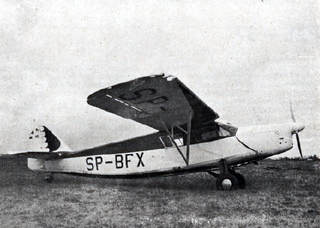
The LWD/WSK Junak was a Polish trainer aircraft, used from 1952 to 1961 by the Polish Air Force and until 1972 by Polish civilian operators. It was designed by the LWD bureau and produced by the WSK Warszawa-Okęcie factory.

The Percival Prentice was a basic trainer of the Royal Air Force in the early postwar period. It was a low-wing monoplane with a fixed tailwheel undercarriage. Front seating was in a side-by-side configuration with a rear seat provided.

The RWD-15 was a Polish touring aircraft of 1937, designed by the RWD team and built by the Doświadczalne Warsztaty Lotnicze (DWL).

PZL.19 was a Polish sports aircraft built in 1932 in the PZL works. Ordered by the Ministry of Communications, it was specifically designed for the upcoming Challenge 1932 contest held that year in Germany.

The Percival Q.6 was a 1930s British communications aircraft built by Percival Aircraft Limited at Luton. Originally, the Percival Q.6 was a civil transport but It was used during the Second World War by the Royal Air Force and Royal Navy as a communications and liaison aircraft. It was a twin-engine, low-wing monoplane with a tailwheel undercarriage.

The Auster J/5 Alpine was a 1950s British single-engined four-seat high-wing training and touring monoplane built by Auster Aircraft Limited at Rearsby, Leicestershire.

The Percival Prince is a British light transport of the early postwar period. It was a twin-engine, high-wing, cantilever monoplane of all-metal stressed-skin construction; the undercarriage was of retractable, tricycle type.

The Percival Mew Gull is a British racing aircraft of the 1930s. It is a small single-engined single-seat low-wing monoplane of wooden construction, normally powered by a six-cylinder de Havilland Gipsy Six piston engine. During the second half of the 1930s Mew Gulls dominated air-racing in the UK, consistently recorded the fastest times until the outbreak of war stopped all civilian flying in late 1939. In addition examples set many long-distance records. Its top speed was 265 mph (425 km/h) on a modest 205 hp (153 kW) in its final 1939 form.

The Chrislea Super Ace is a 1940s British four-seat light aircraft built by Chrislea Aircraft Limited.

The LIPNUR Sikumbang was a low-wing monoplane of mixed construction built in Indonesia in 1954 as a COIN and anti-guerrilla-warfare aircraft. Of conventional configuration, it had fixed tricycle undercarriage and seated the pilot under a bubble canopy. A single example was built under the designation NU-200 in 1954, and another as the NU-225 in 1957. The latter machine was grounded in 1967.

The Miles M.7 Nighthawk was a 1930s British training and communications monoplane designed by Miles Aircraft Limited.

The Miles M.8 Peregrine was a 1930s British twin-engined monoplane light transport designed by Miles Aircraft Limited. A promising design, the Peregrine never entered production as the company was preoccupied by fulfilling orders for other types to the RAF. Only two of the model were built, one prototype M.8 Peregrine, and one modified M.8A Peregrine II which was used for experimentation work at Royal Aircraft Establishment.

The Elliotts of Newbury EoN or Elliotts EoN A.P.4 was a 1940s British four-seat touring monoplane aircraft built by Elliotts of Newbury.

The Vulcanair SF.600 Canguro was a feederliner developed in Italy in the late 1970s. Despite a number of attempts to put the aircraft into series production, only a small number were ever built.

The SAI KZ II was a sport aircraft built in Denmark in 1937, produced in three major versions before and after the Second World War.

The Sparmann S-1 was a 1930s Swedish military training monoplane, designed by Edmund Sparmann, built in small numbers for the Swedish Air Force. The S-1 was a single-seat low-wing braced-monoplane with a fixed trail-skid landing gear. It was powered by a single 130 hp (97 kW) de Havilland Gipsy Major engine.
The Miles Merchantman was a scaled-up and four-engined development of the Miles Aerovan light freighter. It flew in 1947 but the design was abandoned when Miles Aircraft was taken over by Handley Page in 1948.

The PWS-52 was a Polish sports aircraft of 1930, a single-engine high-wing monoplane, constructed by the Podlaska Wytwórnia Samolotów (PWS), that remained a prototype.
The Curtiss-Reid Courier was designed in Canada in 1931 as a specialist, non-passenger carrying, mailplane capable of maintaining services in Canada's hard winters. The 1930s depression led to the end of government subsidised airmail contracts and only one prototype flew. It was lost in 1933 during preparations for a private, long distance flight.
The Yakovlev AIR-11, also known as Yakovlev LT-1, was a 3-seat low-wing touring cabin monoplane designed by A.S. Yakovlev in the USSR, circa 1936.

















